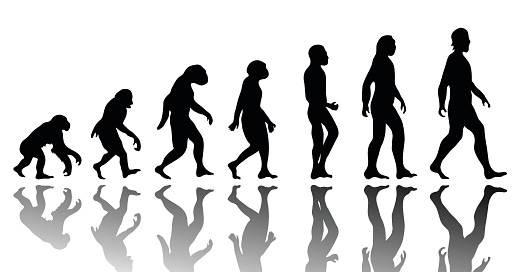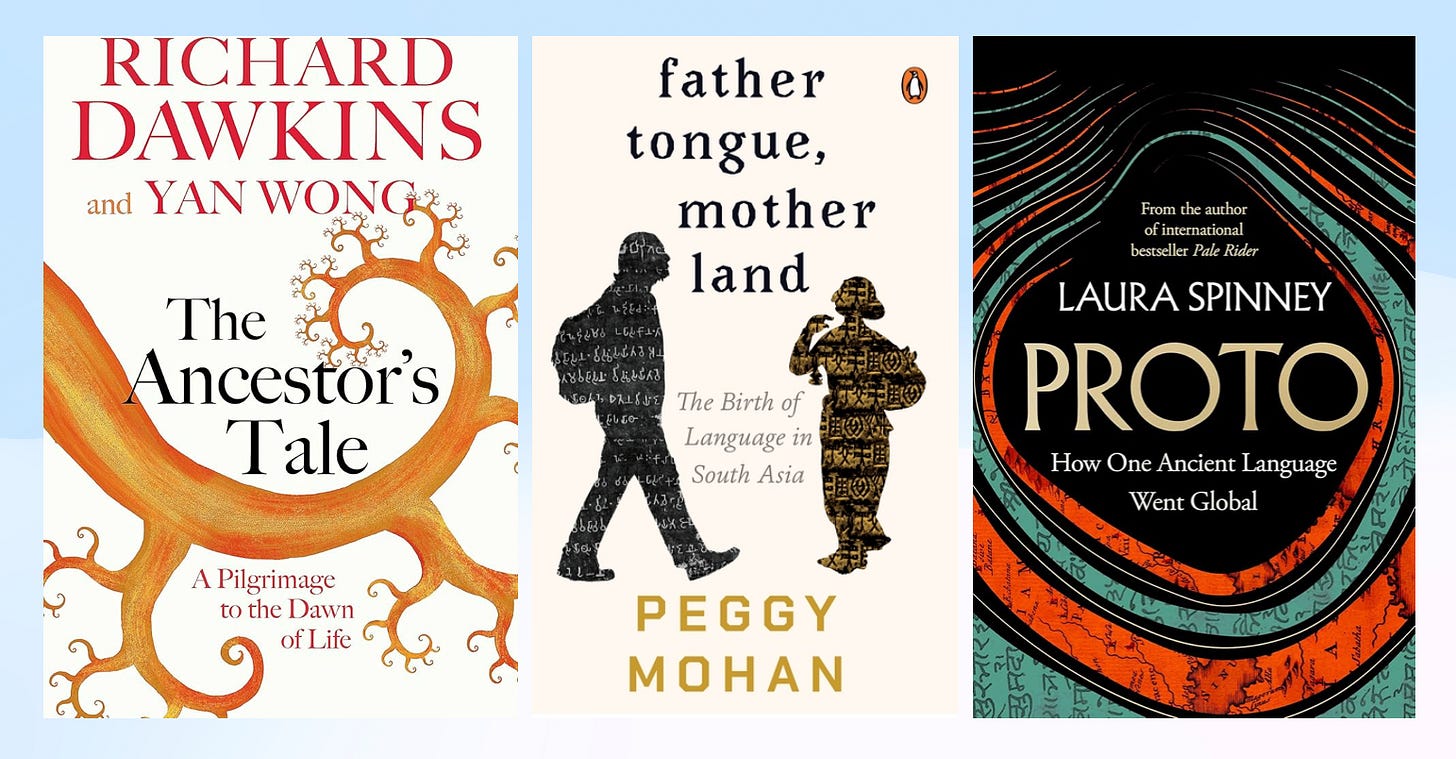This is my first ever blog post with a click bait-y headline. I am not proud of that, so let me answer the question right away. The short answer is No, Kannada was not born out of Tamil. If that is all you wanted to know, then you can stop reading now. If you want a longer, more nuanced answer, please read on. (For those who don’t know why I am talking about this at all, please Google “Kamal Haasan Tamil Kannada statement”).
This is not a blog that concerns itself with current affairs and definitely not with current controversies. So the reason I am writing about this is because I have recently learnt that the way I thought of evolution was all wrong. But if you’re curious about how languages evolve. How they’re like life itself, constantly branching, mutating, and surprising, then let’s dig in. Because this rabbit hole is fascinating.
LUCA and her daughters
When I thought of the evolution of human beings, I would imagine a visual like the one above. Human beings evolved from apes, and apes evolved from monkeys. First the humans were more ape-like, but over time have evolved into the modern creatures that we are. Sounds nice and simple. But real evolution? It’s messier. It’s not a baton relay. It’s a family reunion with sprawling branches, unexpected cousins, and no clear hierarchy. Let’s get into it.
Many scientists believe that the theory of evolution by Charles Darwin is the most brilliant theory of all time, across all sciences. This theory says that all living things on the planet have evolved from other living beings. Over the years, scientists have figured out the path and mechanism of this evolution. So far, so good.
Now come the errors in my understanding. The first error is that I assumed that human beings are the most evolved species on earth. The second error is that I think we evolved from apes and monkeys. Let’s take the second error first.
No living specie has evolved “from” another living species. This is like saying that I have evolved “from” my cousin. My cousin and I may have a common ancestor, but that does not mean that either of us evolved from the other. Similarly, while it is true that human beings are most closely related to chimpanzees and bonobos, this does not mean we evolved from them. It just means that we have a common ancestor.
Around 6 million years ago, there lived a species in Africa (I am afraid the singular of species is also species - I looked this up) that, for some unknown reason, separated into groups. These groups went off to live in different places and different conditions, and, over time, evolved differently. Some of these descendants died out, but three are alive today. One is called a chimpanzee, the second is the bonobo and the third are the homo sapiens.
Evolution is not a relay race where one species hands over the baton to another. Think of it like a giant tree. At the base of the tree is an organism that we call LUCA, which stands for Last Universal Common Ancestor. LUCA was not necessarily the first living organism on earth, but it is the only one whose descendants are still alive. LUCA had some daughters, each of whom became a branch of this tree. Each branch had more branches and so on. One of the sub-sub-sub-sub… branches was the common ancestor of the chimpanzee, the bonobo and Homo sapiens. Each sub-branch will either die out or evolve further. What will happen to ours? Well, just come back in a few million years to find out.
Every single living organism on earth, every bacteria, every plant, every animal, is a descendant of LUCA. And each organism has evolved for exactly the same length of time. Each has experienced 3.7 billion years of evolution. LUCA must have been a microorganism, but that does not mean that any microorganism alive today is exactly like it. Today’s bacteria have had billions of years to evolve and so it would be highly surprising if they were still like LUCA after all these years.
Evolution does not have a purpose. The image above makes us think that all of evolution was designed to finally produced this one great species called Homo Sapiens. That is not so.
A bacteria is as evolved as a human being. This fact takes a bit of getting used to. They’re not less evolved. They’re just differently evolved.
A human being seems to have evolved perfectly to live in the conditions as they exist on earth. But so has a bacteria. Every bacteria alive today has had random mutations in its DNA, the same as our ancestors did. Some of those mutations led to individual members of that species getting an advantage over the others and so survived. The others died out. That is how evolution works.
So what does this have to do with Kannada and Tamil?
PDL and her daughters
Life has existed on earth continuously for around 3.7 billion years. Language has existed for only around 11,000 years. Yet we have a better idea of how life evolved than how languages evolved. While this is work in progress, linguists already know a lot.
Since you know English, do you think you can talk to everyone else who knows English? That sounds like a stupid question. But think about Shakespeare. Is his English easy to understand? And he lived only about 400 years ago.
Let’s go back to around 1000 AD. Somebody living at that time wrote a poem in English which is called Beowulf. This is considered the oldest piece of literature in English and the most important. It is highly prized, highly studied and highly discussed. It’s written in English, so you should be able to understand it. Here are the opening lines of this poem:
Hwæt. We Gardena in geardagum, þeodcyninga, þrym gefrunon, hu ða æþelingas ellen fremedon.
Got it? Hahaha. Here is a modern English translation of the lines above:
Of the strength of the Spear-Danes in days gone by we have heard, and of their hero-kings: the prodigious deeds those princes performed!
The words have evolved. The grammar has evolved. Even the spelling has evolved. You see that languages evolve too. The Hindi that is spoken in Lucknow is not like the Hindi spoken in Hyderabad. And linguists can observe this evolution and learn lots of things about the people who used those languages.
Here is a short history of Dravidian languages. Five thousand years ago, people spoke something that experts call the “Proto-Dravidian Language (PDL)”. We can go back into the history of this language, but let’s keep it simple for now.
The people who spoke PDL were possibly part of the Indus Valley Civilisation or, at least, lived in the same area. Over time, they migrated southward and spread out over Central and Southern India, as also parts of Pakistan, Sri Lanka and India’s North East.
As the people spread geographically, their language changed. Linguists have identified three broad phases of this change. Phase one was around 3,000 years ago, when PDL split into four branches:
Southern Dravidian: Which split later into Tamil, Kannada, Malayalam, Tulu, etc.
South-Central Dravidian: Which subsequently turned into Telugu, Gondi, Kui, etc.
Central Dravidian: Now we see traces in Kolami, Naiki, etc.
Northern Dravidian: Can be heard in Brahui (in Pakistan), Kurukh, Malto
In phase two, these four branches split into the classical languages viz, Tamil, Kannada, Telugu etc. And finally in phase three, the classical languages evolved into the forms we use today.
So, No—Kannada Didn’t Come From Tamil
All Dravidian languages have a common grandmother and some have a common mother. They are all siblings or cousins. One is older than the other, but that does not mean that the younger evolved from the older. Tamil is the oldest of the modern Dravidian languages, but that does not make it the mother. Merely the venerated oldest cousin, who likes to remind everyone that she was here first.
Here are some books, that I would recommend for further reading. I have taken material from them in putting together this post.





I am fascinated by how languages have evolved so this was click-bait for me. Thanks, worth the read and loved the book recommendations.
Excellent research and communication.
Changes your understanding of ancestry.